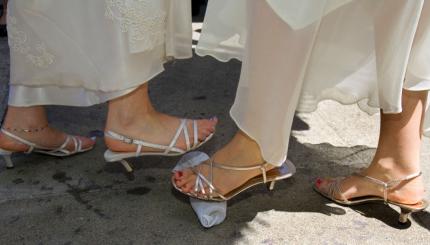There is no doubt that love is in the air—as a hopeless romantic, Valentine’s Day is a holiday I always want to celebrate. Sure, it’s hard to make an argument for Valentine’s Day as a Jewish holiday, but every holiday can’t be perfect. And the argument that the day has become all about commercialism isn’t lost on me—although I’m willing to forgive any holiday that is accompanied by such fantastic discounts on chocolate. The day isn’t perfect, but it gives us an opportunity to think about love—and think about how to celebrate love.
As a wedding photographer, I’m part of many couples’ celebrations of love. If you think navigating the ins and outs of Valentine’s Day shopping is complicated, you should try planning a wedding. To say a lot goes into it is an understatement—and as the photographer, I need to know it all. Where—and when—will you be singing the
ketubah
? What is the story behind your
chuppah
? Will there be a tish or a
bedekn
? Will you both be stepping on the wine glass? The questions go on and on.
Last week, perhaps inspired by pervasive and inescapable Valentine’s Day decorations, I sat down with a few of my wedding planning forms. The forms ask all of the questions—the whens, the wheres, the whos, the hows, and the whats. My forms, which were passed on to me by others in the business, ask some pretty basic questions, like “What will the bride be wearing?,” or, “When will the groom head to the ceremony site?” Over the course of the past few years, I’ve updated forms to meet the needs of my couples. Now, I no longer have a “one size fits all” form, but instead one for a bride and groom, a groom and groom, and a bride and bride.
As the number of states legalizing gay marriage continues to rise, I’ve seen more and more wedding photographers figuring out how to update their contracts and forms. Even though it seems like a small detail, the forms that wedding professionals use help to set the tone. When I sat down with my forms last week, I made the decision to update to one single gender neutral form—one that refers to the couple simply as “the couple,” and asks for details regarding “partner one” and “partner two.” While I want my wedding couples to feel as if every detail of their process is customized to their specific needs, I also want to set a tone of inclusion—making it clear that I welcome couples that fall into any and all gender categories.
When we celebrate love, we should be celebrating inclusion. So, should your Valentine’s Day plans tomorrow night lead you to the chuppah, here’s to a celebration that welcomes everyone.
If you’re looking for more information on Jewish clergy and institutions dedicated to inclusion, check out Keshet’s Equality Guide.

